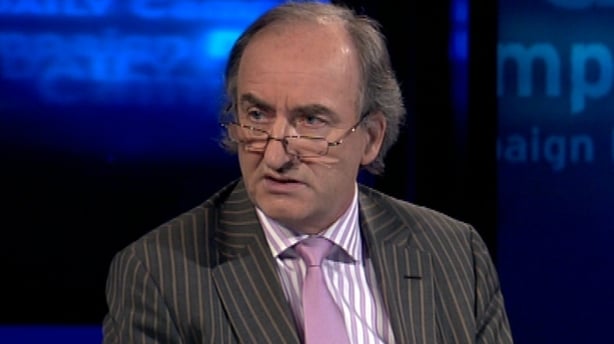By Pollster Sean Donnelly
The general election for the 31st Dáil was held on 25 February 2011. The new Dáil first met on 9 March 2011 and the 29th government was formed. The maximum term for the Dáil is five years from the date it first met following the last general election, so the Dáil has to be dissolved by 9 March. An election must take place no later than 30 days after a dissolution of the current Dáil, meaning the next General Election will have to be held before 9 April.
With St Patrick's Day on 17 March and Easter Sunday falling on 27 March, the outgoing Government will not want to be campaigning over the Bank Holiday and Easter periods – including the centenary of the 1916 Rising – and may well prefer to have the new government in place before then.
This would point to an election day of Friday 11 March with the Dáil dissolved three weeks earlier on Thursday 18 February.
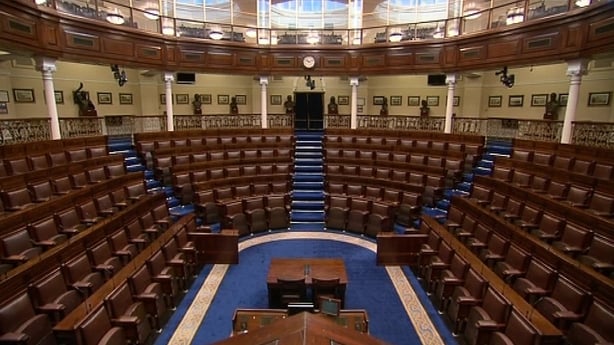
Methodology
The performance of each party and others is assessed from the numerous polls which have been published by The Sunday Business Post, Irish Independent, Sunday Independent, Sunday Times and a few by bookmaker Paddy Power. A total 125 polls have been included.
The parties are listed in order of representation in the Dáil with smaller parties and independents listed as "Others". The table below shows the average yearly poll results since the last election in 2011.
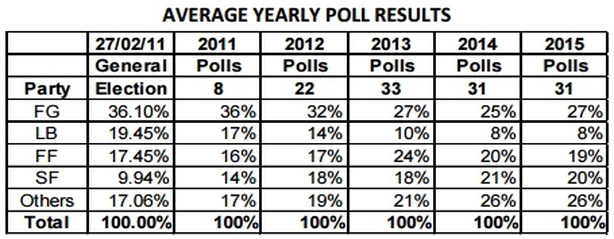
Bonus Seats Calculation
Under our Proportional Representation Single Transferrable Vote system, a party should get an equal share of seats to votes.
In other words, if a party gets 20% of the first preference vote it should get 20% of the seats. This would give a "% seats" to "% votes" ratio of 100%. But the aim is to do better than this.
The table below shows the bonus seats achieved in 2011 and the S/V Ratio. There were 21 bonus seats in play in 2011 mainly because of the collapse in the Fianna Fáil vote.
But that is unlikely to happen at the next election. There is less scope for large bonuses as no party is likely to dominate this election and there are eight seats less this time.
The outgoing Ceann Comhairle, Seamus Kirk, was returned automatically in 2011 hence only 165 seats were actually contested.

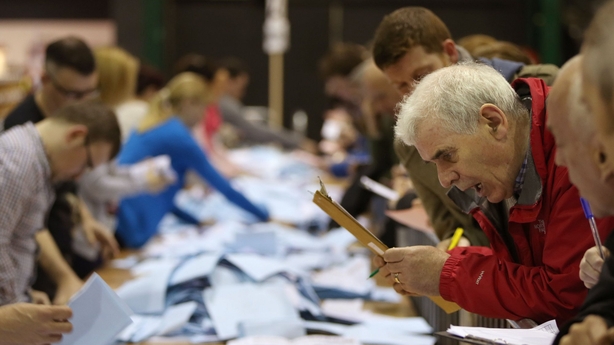
Local Elections 2014
The table below shows the final poll prior to the local elections in 2014 and the actual results including bonus seats and S/V ratio. The Sinn Féin vote was overestimated at the expense of Others as it failed to get its vote out, which has been a feature of its electoral performance in the past.

A recent poll from the Sunday Business Post produced the following results...
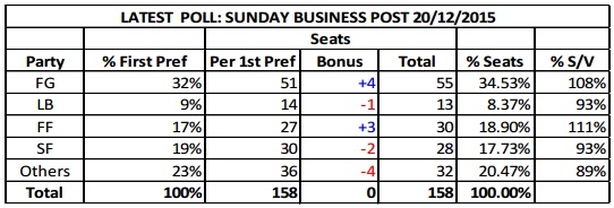

Party Prospects
Fine Gael
Fine Gael had one of its best elections in 2011, winning 36% of the first preference votes and 46% of the seats. This resulted in a S/V ratio of 128%, the best ever by any party. This gave the party a seats bonus of 16 and a total of 76 seats, the most won by the party to date.
Its opinion poll support held up in the period after the election in 2011 but was down to 32% in 2012, a drop of four points. It suffered a further drop of five points in 2013 and was down to an average of 25% for 2014, a drop of 11 points since the last general election.
The debacle that is Irish Water was seen as the main reason for its loss in support, but it is obvious from the above that party support has declined since 2012 and the water issue only added to this decline.
It dropped to its lowest level of support, 19%, in December 2014 and seems to have bottomed out at that level as support has steadily climbed this year and was up to 32% at the end of the year.
Fine Gael will be hoping to continue this rise into the new year. But with its vote likely to be down on 2011 and with eight seats less on offer, it is unlikely to get much of a bonus.
It achieved a S/V ratio of 103% in the 2014 local elections but I am sticking with its historical average of 107% for the General Election and this gives the party a total of 55 seats, a loss of 21 since 2011.
The Labour Party
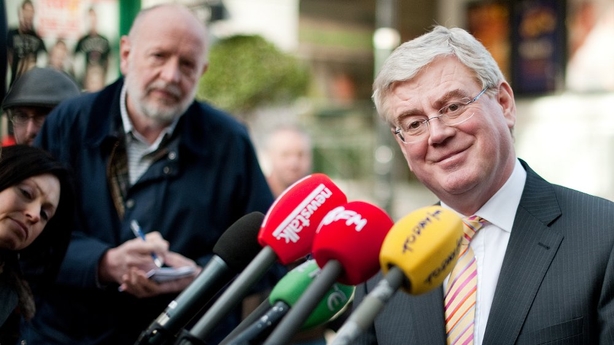
The Labour Party had one of its best elections under Eamon GIlmore in 2011 when it won 19.45% of the first preference vote.
It was its second best share to date – only bettered by its 21.33% in 1922 – and it won a record 37 seats with a S/V ratio of 115%, its third best to date.
This performance compares well with the "Spring Tide" election of 1992 when Labour won 33 seats from 19.31% for a ratio of 103% but at a time when Fianna Fáil had 39% of the vote and Democratic Left held four seats.
The decline in the Labour Party's support since 2011 followed a similar path to its coalition partners but with a much more damaging effect.
It got 19.45% at the 2011 election, but it was all downhill after that with its vote down to 17% for the rest of 2011.
It dropped a further three points in 2012 and was down another four points in 2013 and down two to 8% in 2014, a drop of 11 points since 2011.
So both government parties have suffered a decline in support but Labour, coming from a much lower base, can least afford it.
The latest poll shows it at just 9% which would give it just 14 seats but they are unlikely to achieve the 100% S/V benchmark as it is in decline and is more likely to be nearer its 2014 local elections level of 75%.
I have given Labour a ratio of 93%, which is just below its historical average of 95%, to give a negative bonus of one seat and 13 seats in total.
This would reflect its poor election in 1997 when coming off an excellent result in 1992, it dropped from 33 seats to just 17.
Fianna Fáil
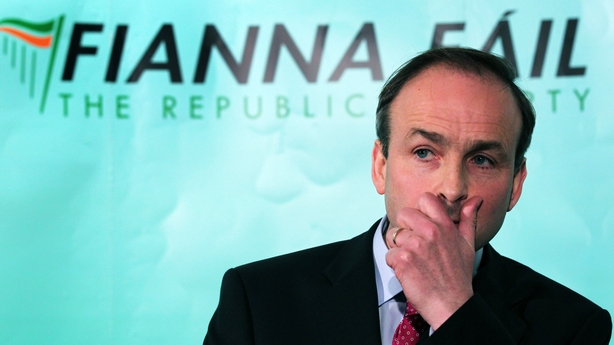
The Fianna Fáil vote collapsed in 2011 to its lowest level – 17.45% – since the party was formed in 1926 and it ended up with just 19 TDs elected plus the outgoing Ceann Comhairle and got its worst S/V ratio of just 66%.
There was no improvement in its vote following the general election and it remained static during 2011 and 2012. Its fortunes improved in 2013, averaging 24%, but that was as good as it got as it slipped back to an average of 20% in 2014 and now stands at an average of 19% for 2015. So no real improvement.
But it had good local elections in 2014 when it won practically the same 25.31% as it got in the previous locals in 2009 (25.38%) but it was enough to overtake Fine Gael whose vote was down eight points to 24.03%.
This one-point difference between the two parties was enough to change the complexion of this election with Fianna Fáil becoming the largest party and making a tentative start to its recovery from its near wipeout in 2011.
Fianna Fáil has historically achieved a seats-to-votes ratio of 107% (the same as Fine Gael). It upped this to 111% in the locals in 2014 and I am giving it 111% in this projection with a bonus of three seats to give it a total of 30.
Sinn Féin

When Fianna Fáil was a 40%-plus party, the polls were inclined to exaggerate its popularity. The Irish Times decided to introduce an adjustment process with Fianna Fáil usually losing vote share. This adjustment worked well but later, when Fianna Fáil went into decline and was no longer a large party, the Irish Times continued its adjustment which was no longer applicable.
It later dropped it and went back to their normal process. It may now be time to introduce a similar adjustment for Sinn Féin as its sharp rise in popularity has nearly doubled its support from 10% in 2011 to 19% in the latest poll. There may be an element of exaggeration in this acute rise.
The polls had Sinn Féin at 10% going into the 2011 general election and that is what it achieved but it went into the locals with 20% and came out with 15%, a relatively large difference of five points. One of the reasons for this is that its support is more working class-based and these voters are less inclined to turn out.
The polls were correct when Sinn Féin was at its more normal level but when its support shot up, the rate of increase was probably exaggerated. It may take another election to see how this over-estimation of Sinn Féin support pans out.
The party's support increased sharply following the last general election and was up four points for the rest of 2011. It increased another four points in 2012 and remained static in 2013 and was up another three points in 2014 to 21%. Support seems to have flattened out since then and Sinn Féin got 19% in the latest poll, an increase of nine points since 2011.
There may be some doubt about Sinn Féin's poll ratings but there is no doubt about its improvement in the S/V ratio as it went from 85% in 2011 to 110% in 2014 and gave the lie to the general view that Sinn Féin falls short in an actual election mostly because it does not get transfers.
That was fine when Sinn Féin was a party stuck on 5%. It is now a completely different animal and looks like becoming one of the major parties in the next Dáil and with many of its winning candidates likely to be elected early in the count, lack of transfers will not be relevant.
I think it will just fall short of the 100% S/V ratio and lose two seats to give it 28, a near doubling of its TDs.
Others
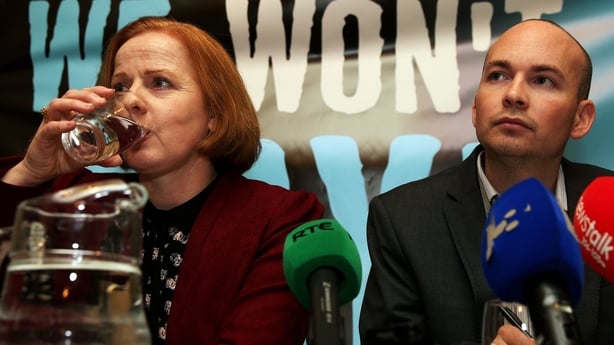
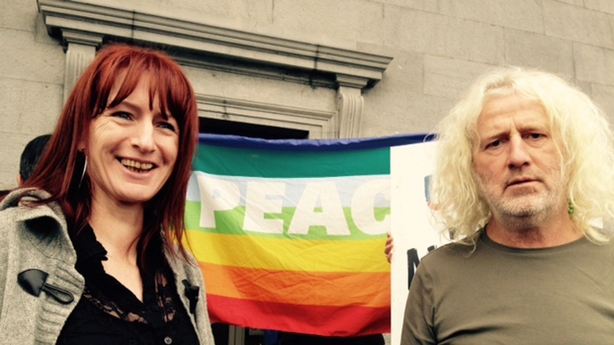
Smaller parties and Independents did well in 2011 and got 17% of the first preference vote. This group is so diverse is cannot be treated like a party and is less likely to come together into a single unit, and so it was at the last general election with Others falling well below the 100% S/V ratio and instead of winning 28 seats, they got 19 or a negative bonus of nine and a S/V ratio of just 67%.
They upped this to 89% in the locals in 2014 and I am giving them something similar – 89%, or a negative bonus of four. This group is now a major player and at an average of 26% in this year’s polls, it will be in with a chance in all 40 constituencies.
Government
The outcome of the 2011 general election has changed the political landscape completely. The collapse of the largest party, Fianna Fáil, has fractured the normal voting patterns with Fine Gael, Labour, independents and to a lesser degree Sinn Féin the main winners.
But that all looks like changing again at the next election with Sinn Féin and others best placed to take advantage of the Government's unpopularity, with Fianna Fáil showing some progress.
With no big beast now in play, there are four blocks of similar size – Fine Gael, Fianna Fáil, Sinn Féin and Others. It will take at least two of these to form a government. The most likely combination will be a coalition for the first time of Fine Gael and Fianna Fáil, with possibly 84 seats between them, which is enough for an overall majority.
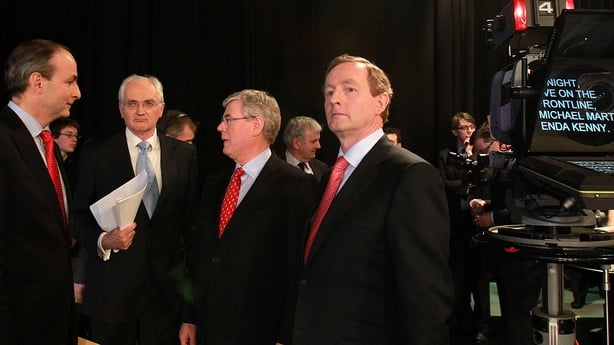
We have seen from the last election that large majorities do not guarantee good government. In fact, the 1997-2002 Bertie Ahern-led government was probably the best of recent governments and it had to depend on the votes of four independents. This Fianna Fáil/Fine Gael coalition would leave Sinn Féin as the main opposition party along with Labour, smaller parties and Independents with 74 seats between them.
Ironically the more Sinn Féin improves, the less chance it has of being in government as its most likely partners, Fianna Fáil or Fine Gael, are unlikely to play second fiddle to it and instead will be forced to come together.
This outcome would herald the end of civil war politics, something which is long overdue with very little difference between the two parties 92 years after the Civil War. It would also, for the first time, give a right-left divide and reflect the more normal European-style politics.
In summary, the most realistic and stable government likely to emerge after the next general election will be a Fine Gael/Fianna Fáil coalition.
This would be attractive to Fine Gael, as it would mean Enda Kenny would become the first Fine Gael Taoiseach to lead the party into government for a second successive period. It would also be a great lift for Fianna Fáil to be back in government after just one Dáil in opposition.
If required, it would also be a lifeline for Labour to be back in government after such a run of bad results. There are also attractions in this outcome for Sinn Féin as it would become the largest party in opposition and would not be tainted by being in government going into the following election.
This result would also suit the smaller parties and Independents, as it places them at the forefront of opposition with even the possibility of entering government if the FF/FG coalition falls short.
Thus while all parties can look forward to a chance of being in government, for the Labour Party it is all about survival with its poor local election performance and ongoing poll ratings indicating it will be under pressure. It will be hoping for an improvement following the Budget and at least getting back to its more normal 10%-11%.
Conclusion
The political landscape changed at the last election in 2011 with the collapse in the Fianna Fáil vote. This change has continued apace since then with both government parties losing support, with Sinn Féin and Others the main beneficiaries, and Fianna Fáil not yet showing any signs of recovery.
This fracturing of the normal political landscape means that it will be difficult to form a government after the next election.
The recent polls indicate that the most likely combination of Fine Gael and Fianna Fáil would have around 84 seats between them.
That would be tight but still enough for a working majority. If these two parties fell short, the obvious party to fill the deficit would be the Labour Party but it will not have it all its own way as its negotiating position could be weakened by the presence of one or other of the new parties or alliances that have recently formed.
In other words, every party including the smaller parties and any new party or alliance will be in with a chance of being in government after the next election. In fact, every TD elected at the next election, including all Independents, will have a chance, some more than others, of being in government.
The latest polls indicate Fine Gael will have 50-plus seats after the next election, with Fianna Fáil on 30-plus along with Sinn Féin and Others.
This indicates FG will be the leading party and, along with one of the other three groups, will have 80-plus seats, enough for an overall majority. Who Fine Gael decides to go with is another matter – but FF looks the favourite at this stage.
Whatever doubt there is about the composition of the next government, there is no doubt about who the next Taoiseach will be.
Enda Kenny is set to be the first Fine Gael leader to win two consecutive General Elections and, by election day, he will have passed out Garrett Fitzgerald to become the second longest serving Fine Gael Taoiseach behind John A Costello (1948-1957).
WT Cosgrave served five terms (1922-1932) but that was as leader of Cumann na nGaedheal as Fine Gael was not formed until 1937.
By Political Analyst Sean Donnelly
